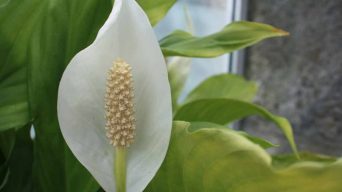ZZ plant care can be pretty straightforward. These easy-to-care-for plants are known for being tough and resilient, but even the hardiest of plants can have problems from time to time.
So, how can you tell if your ZZ plant is healthy?
The best way to tell if a ZZ plant is healthy is to check the leaves.
Healthy plants will have dark green leaves with no signs of wilting or yellowing. If the leaves show any of these signs, it indicates that the plant is not healthy.
Here you’ll find everything you need to know about whether your ZZ plant is healthy and how to keep it that way!
Signs of a Healthy ZZ Plant
Knowing the signs of a healthy Zamioculcas zamiifolia is the first step in being able to properly care for your plant.
These plants are known for being tough, but they can still have problems from time to time.
The most common signs of a healthy ZZ plant are:
The Leaves Are Glossy and Green
The ZZ plant is a popular houseplant that is known for its glossy, dark green leaves.
As you may already know, leaves are an essential part of a plant’s life cycle. They produce food for the plant through photosynthesis and also help to regulate the plant’s temperature.
In addition, leaves play an important role in protecting the plant from environmental stressors.
One way to tell if a plant is healthy is by looking at the color of its leaves. If the leaves are glossy and green, it is a sign that the plant is getting the nutrients it needs and is able to withstand stress.
However, if the leaves are dull and yellow, it may be a sign that the plant is not getting enough light or water.
If you notice that your plant’s leaves are not as green as they should be, you may need to adjust its care regimen. With a little effort, you can help your plant thrive.
The Plant Is Growing New Leaves
In addition to looking at the color of the leaves, you should also pay attention to the plant’s growth.
A healthy ZZ plant will produce new leaves on a regular basis.
This is a sign that the plant is getting the nutrients it needs, which is a good indicator of its overall health.
If you notice that your plant is not producing new leaves, it may be a sign that it is not getting enough light or water.
Adjusting the care regimen can help the plant to start producing new leaves again.
The Stems Are Green and Firm
Another way to tell if a ZZ plant is healthy is by looking at the stems. The stems should be green, firm, and not drooping.
If the stems are yellow or brown, it may be a sign that the plant is not getting enough water.
Additionally, if the stems are soft or limp, it may be a sign that the plant is not getting enough light.
Adjusting the care regimen can help the plant to start producing new leaves again.
The Roots Are White and Healthy
Another way to tell if a plant is healthy is by looking at the roots. The roots of a healthy ZZ plant will be white and healthy-looking.
If the roots are brown or black, it may be a sign that the plant is not getting enough water or that the roots are rotting.
You can also check the roots by gently pulling on the plant. If the roots are white and healthy, they will be securely attached to the plant.
If the roots are brown or black, they may come off easily, which indicates that they are unhealthy.
The roots of a healthy ZZ plant should also be firm, not mushy. This is an indication that the ZZ plant is underwatered or overwatered.
Mushy roots can also be a sign of root rot, which is a serious problem that can kill a plant.
If you notice that your plant’s roots are mushy, you will need to take action to save the plant.
Signs of an Unhealthy ZZ Plant
Knowing the signs of an unhealthy ZZ plant is just as important as knowing the signs of a healthy one.
Some common signs of an unhealthy ZZ plant are:
The Leaves Are Dry and Brittle
One way to tell if a plant is unhealthy is by looking at the leaves. If the leaves are dry and brittle, it is a sign that the plant is not getting enough water.
ZZ plants must be watered at least once a week and more often if the soil is dry. If you notice that the leaves are dry and brittle, you will need to water the plant more frequently.
Dry and brittle leaves can also be a sign of excessive heat or direct sunlight. If the plant is in a sunny spot, you may need to move it to a shadier location.
The Leaves Are Turning Yellow or Brown
Yellow or brown leaves can indicate several problems, including nutrient deficiency, overwatering, or direct sunlight.
You need to take a closer look at the plant to determine the cause of the problem. If the ZZ plant leaves are yellow and you think the plant is getting too much water, you will need to reduce the frequency of watering.
Also, when the leaves are yellow or brown, and you think the plant is not getting enough water, you will need to increase the frequency of watering.
If the leaves are yellow or brown and you think the plant is getting too much sun, you will need to move it to a shadier location.
The Leaves are Falling Off
If the ZZ plant leaves are falling off, it is a sign that something is wrong. The most common cause of this problem is overwatering.
When a plant is overwatered, the roots cannot take in enough oxygen, and the leaves start to die. If you notice that the leaves are falling off, you will need to water the plant less frequently.
Other causes of leaves falling off include excessive heat, direct sunlight, or nutrient deficiency.
The Plant Is Wilting
If the plant is wilting, it is a sign that it is not getting enough water. You will need to water the plant more frequently if you notice that it is wilting.
Wilting can also be a sign of excessive heat or direct sunlight. If the plant is in a sunny spot, you may need to move it to a shadier location.
The Plant Is Growing Slowly
If the plant is growing slowly, it is not getting enough nutrients.
ZZ plants need to be fertilized at least once a year to ensure that they are getting all the nutrients they need.
If you notice that the plant is growing slowly, you will need to fertilize it more frequently. You can also add some compost to the soil to help the plant get more nutrients.
The Plant has Spots on the Leaves
If the plant has spots on the leaves, it is a sign of a disease or pest problem. The most common cause of this problem is mealybugs.
Mealybugs are small, white insects that feed on plant sap. They can be difficult to control, but there are several ways to get rid of them.
If you notice that the ZZ plant has white spots on the leaves, you will need to take action to get rid of the mealybugs.
Fungal diseases can also cause spots on the leaves. The most common type of fungus is powdery mildew.
Powdery mildew is a white, powdery fungus that grows on the leaves of plants. It can be difficult to control, but there are several ways to eliminate it.
If you notice that the plant has spots on the leaves, you will need to take action to get rid of the fungus.
You can also try to prevent powdery mildew by spraying the plant with a fungicide weekly.
The Plant Has Leggy Growth
If the ZZ plant has leggy growth, it is a sign that it is not getting enough light. ZZ plants need to be in a bright location to thrive.
When ZZ plants are grown in low light conditions, they start to stretch out in search of light. This can cause the leaves to become thin and weak.
If you notice that the plant has leggy growth, you will need to move it to a brighter location.
You can also try to prevent leggy growth by pruning the plant regularly. This will help encourage the plant to grow in a more compact manner.
How To Care For and Keep Your ZZ Plant Healthy
ZZ plants are low-maintenance plants that are perfect for beginners. With just a little bit of care, you can keep your ZZ plant healthy and happy.
Here are a few tips to help you care for your ZZ plant:
- Water the plant when the soil is dry. ZZ plants are drought-tolerant and don’t need to be watered often.
- Use a well-draining pot and potting soil mix. ZZ plants don’t like to sit in wet soil.
- Fertilize the plant during the growing season. Use a liquid fertilizer diluted to half-strength.
- Place the plant in a bright indirect light. ZZ plants can tolerate low-light conditions but will grow faster in brighter light.
- Trim off any brown or yellow leaves. These leaves are dying and should be removed to help the plant look its best.
- Repot the plant every one to two years. ZZ plants prefer to be slightly root-bound, so don’t worry about repotting too often.
- Keep an eye out for pests and diseases. ZZ plants are relatively resistant to pests and diseases, but checking your plant regularly for any problems is still a good idea.
Following these tips will help you keep your ZZ plant healthy and happy. ZZ plants are tough plants that can tolerate a lot of neglect but will thrive with just a little care.
Final Thoughts
Zamioculcas zamiifolia, or ZZ plants, are popular houseplants because they are relatively easy to care for.
However, even though they are low maintenance, checking on your ZZ plant regularly is important to ensure it is healthy.
This will help you catch any problems early and ensure your plant stays healthy and happy.







